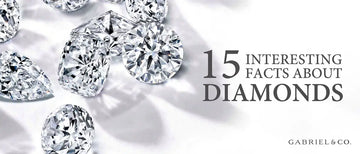
Diamonds, those shiny symbols of love, and all that jazz, are some of the most incredible rocks on Earth. You might think you know the whole deal about these sparklers, but get ready for some seriously interesting facts about diamonds. From their glitzy looks to their fancy history and deep meaning, diamonds are way more fascinating than you'd think.
Fact Check: Trivia Questions About Diamonds
1. Origin of the term ‘diamond’: The term ‘diamond’ comes from the Greek word Adamas, meaning non-breakable, durable, and scratch-resistant. Ancient Romans and Greeks believed diamonds were formed by Gods' tears and Cupid's arrowheads and symbolized protection.
2. Diamond is made of a single element: You read that right. An easily available element, carbon, the main ingredient of a diamond, is formed when a singular carbon atom merges with up to four other atoms to create a three-dimensional crystalline composition through its built-up chemical bonds.
3. The importance of heat and pressure: Heat is essential for bonding carbon atoms and bringing diamonds to the surface- precisely, a whopping 725,000 pounds per square inch of pressure at a blazing temperature of approximately 2200°F. Additionally, diamonds are pushed up to the surface through volcanic eruptions.

18K White Gold Round Three Stone Diamond Engagement Ring
4. A diamond in the sky: An astounding discovery made in 2007 proved the existence of a 10-billion-trillion-trillion-carat diamond in the sky called ‘Lucy’, named after a popular Beatles song. It is located fifty light years away from the Earth.
5. India-the first diamond hub: Being the first country to have discovered diamonds, ancient Indian culture encourages embedding these rare stones in the statues of their gods and deities. With time, as Indian reserves started depleting, other mines were developed globally.
6. Getting engaged with a diamond ring - a royal tradition: A status symbol of the elite, the tradition of gifting diamond engagement rings goes back to the year 1477 when Archduke Maximillian of Austria proposed to Mary of Burgundy.
7. The after-effects of the cutting and polishing process: This process ensures the rough diamond reaches its full potential, during which the diamond loses up to 50% of its original rough carat weight.
8. Not all diamonds are colorless: Various natural diamonds are formed in color – yellow, red, pink, blue, brown, orange, etc. – and have unique characteristics and inclusions.

14K White Gold Lab Grown Emerald Cut Diamond Eternity Band
9. The most common yellow diamonds: Yellow diamonds, comprising 60% of natural colored diamonds, are also known as Canary yellow diamonds due to their varying tonality and fancy appearance.
10. Cullinan diamond: This diamond, which was the biggest ever discovered (weighing 3106 carats), originated in South Africa around 1900, when it was given to King Edward by a mine owner. Parts of it are currently on display in the Tower of London.
11. Discovery of the Eureka diamond: Brownish yellow in appearance, with its rough structure weighing 21.25 carat, this gem was accidentally discovered by a 15-year-old boy named Erasmus Stephanus in 1867 in South Africa.
12. Mining countries: The US is the world's largest diamond market, with Russia, Botswana, Canada, Angola, and South Africa producing 88% of the world's diamonds.
13. One in a million: In reality, around 1 million units of mined rock yield only one part diamond. Miners can roughly locate one pound of diamond for every one million pounds of the diamond-bearing host rock (a whopping 500,000 metric tonnes), leading to limited production.

14K White Gold 1.50ctw Natural Square Diamond Studs
14. Most mined diamonds are unsuitable for making jewelry: Due to their exceptional endurance, diamonds are used in a variety of industrial applications like cutting, drilling, and polishing, and therefore, 80% of the incompatible mined diamonds are converted into industrial diamonds.
15. Dig your own diamond: The Crater Diamond State Park in Arkansas, US, is a spot where you can legally mine a diamond and retain that stone. Interested much? Holding a volcanic pipe, this park produces white, yellow, and brown-tinted diamonds.
Written By: Gabriel Editorial Team






























